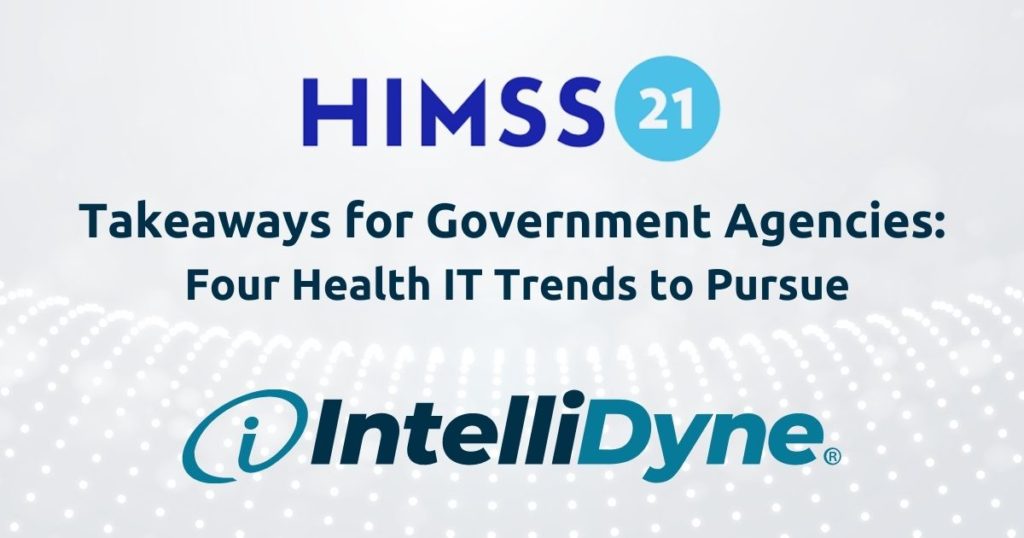Several IntelliDyne defense health experts attended the annual HIMSS21 conference in Las Vegas this summer. Despite in-person attendance being about half of what we’ve seen in the past due to COVID-19 concerns, nearly 20,000 people attended across multiple venues. Experts shared their perspectives on the future of artificial intelligence, cybersecurity resilience, data-based decision making, and public health transformation, and the insights were just as impactful as in previous years. Not surprisingly, many conversations were dominated by the impacts and long-term effects of the global pandemic, which continues to generate new challenges and risks
1. Data Analytics
A key component to success with health data management in the public sector is to provide a centralized analytics and monitoring capability across disciplines to inform decisions and optimize impact. HIMSS attendees were encouraged to leverage analytics-based technology solutions to provide visibility into enterprise resources and create measures of performance for overarching infrastructure efficiencies. By focusing objectively on the data, federal health leaders can realize infrastructure efficiencies, identify process and component redundancies, and drive technology standardization during and post Desktop to Datacenter (D2D) implementation. The most successful public health programs implement processes and tools that will help enterprises recoup costs while driving citizen satisfaction.
2. Healthcare Innovation
Dr. Roger Boodoo, CDR MC USN DHA Health Informatics Enterprise Imaging and Clinical Informatics, U.S. Department of Defense, discussed healthcare in the future in his session titled “DHA Innovation Experiences and Future Roadmap.” Dr. Boodoo spoke of making space for disruptive change. He reported successes applying human-centered design and innovation in the electronic health record (MHS GENESIS) to deliver novel practices of strategic importance.
Dr. Boodoo explained that objective-driven innovation emphasizes investing in understanding before investing in solutions/strategies. He shared lessons learned from an (enterprise) architecturally based interoperability initiative to align clinical and administrative data from multiple Systems of Record (SORs). He offered attendees a roadmap for leading a high-impact enterprise innovation:
– Discover – Find the right problem to solve for the people you serve
– Define – Set the direction for addressing the problem you’ve identified
– Design – Create solutions that are desirable, viable, and useful
– Deliver – Present the solution to the market in a successful business model
– (Re)Develop – Continue to innovate and grow the service
Dr. Boodoo emphasized that government agencies can de-risk disruptive change by fostering innovation at the grassroots level, which yields high-reward initiatives.
3. Health IT Integration
DHA Chief Information Officer, Pat Flanders, addressed an audience of nearly 1,000 attendees about enterprise integration at the Defense Health Agency (DHA). His remarks came as part of a presentation titled “Making IT Boring Again – Priorities, Progress, and Pandemics,” which he presented with Tom Hines, DHA Director of Engineering and Technology Transformation. Together they recounted the steady, quiet progress they made toward rationalizing the enterprise IT of more than 200 disparate services and solutions. The point of “boring” to these two trailblazers was that proven solutions and reliable performance can be combined into the most accessible, optimized, and secure systems. They emphasized that the IT integration and standardization required to complete an enterprise-wide transformation means continued monitoring, decommissioning of legacy systems, optimization of storage, and increased automation.
IntelliDyne supports DHA’s vision to transform the way the agency provides IT support services across the enterprise as it incorporates the Military Treatment Facilities (MTFs). With the oversight of the Enterprise IT Service Integrator (EITSI) and support of trusted partners such as the Geographic Service Providers (GSPs) and Capability Service Providers (CSPs), the agency can consolidate and standardize IT service delivery to lead the Military Health System (MHS) more efficiently. The shift to the service integration and management model will reduce redundancies and advance the overall goal of increased readiness, better health, better care, and lower cost.
4. Robotic Process Automation (RPA)
RPA has been emerging and creating an impact in the healthcare technology space since the early 2000s. Intelligent automation gives public health programs the ability to accelerate processes, drive larger efficiencies, and improve patient engagement like never before. With RPA bots doing the heavy lifting for agencies, health IT leaders can automate routine tasks, allowing the federal workforce to better focus on high-value responsibilities that benefit from human interaction.
Automation should be billed as a complement to the workforce–not a replacement. RPA does not replace positions but assists with fluctuations in workloads and staffing, allowing employees to be allocated to more rewarding tasks and projects. The benefits of RPA in federal health programs include improved scalability and efficiencies, improved quality and compliance, labor savings, and reduced waste.
What Should Federal Health Agencies Do Now?
While working to innovate and modernize, federal health agencies must also go back to the basics and be sure they have a strong foundation. The sentiment of “Make IT Boring Again” was a steady drumbeat throughout HIMSS21 and should not be ignored.
1. Go back to the basics on major business and technical initiatives like data analytics and cybersecurity. Make sure these areas of your public health programs are relentlessly following best practices.
2. Focus on DevSecOps innovations that improve citizen outcomes and mission value by automating, monitoring, and applying security at all phases of the software lifecycle: plan, develop, build, test, release, deliver, deploy, operate, and monitor.
3. Invest in modernization and integration of force multiplier IT solutions that optimize operations and enhance citizen experiences like cloud, O365, and DMLSS.

